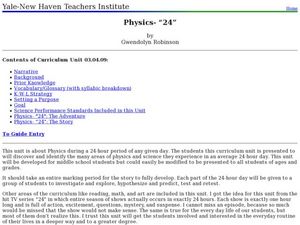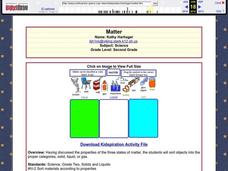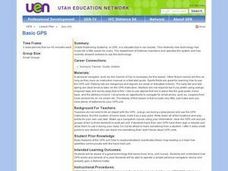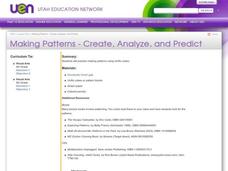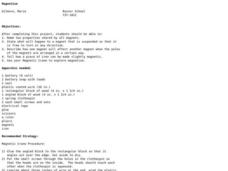Curated OER
Body Language? The Language of Contemporary Fashion
Young scholars examine the messages given to others based on their clothing. In groups, they compare and contrast the clothes of today with those from the 1980s. While being shown a picture of a piece of clothing, they practice object...
Curated OER
The Physics of Sound: How We Produce Sounds
Young scholars are introduced to how they produce sounds. In groups, they participate in experiments in which they measure sound and identify their five senses. Individually, they make their own musical instruments using different...
Alabama Learning Exchange
Why Does It Rain?
Students investigate the water cycle. They observe a demonstration of the water cycle involving ice, water, bowls, and steam, explore various websites, and listen to the book, "The Magic School Bus: Wet All Over: A Book About the Water...
Curated OER
Water: Our Most Important Beverage
Third graders complete a KWL chart on what they already know about water and what they want to know. As a class, they participate in an activity in which they discover the amount of drinkable water on Earth and are introduced to the...
Curated OER
What's the Matter with My Snow?
Middle schoolers collect snow samples around their school. They explore the concepts of density and phase change as well as the math skills of measurement and statistics. Students explore the water cycle through an interactive, down...
Curated OER
The Relationship Between Salinity and the Density of Water
Students investigate density and salinity of water. In this density and salinity lesson plan, students find the density of objects and liquids and show the relationship between the salinity and density of water. Students add salt to...
Curated OER
Beads, Balls, and Beakers
Students analyze the amount of space required to pack round objects. In this geometry lesson, students practice using space economically by practicing packing spheres into beakers. They then translate this concept to molecules being...
Curated OER
Physics "24"
Students construct a model house or school. In this physics lesson, students research about who wind up clocks work and write an essay about it. They determine the center of gravity of different objects.
Curated OER
Sound
Students identify sources and importance of sound, discuss sounds heard on way to school, explain why sound waves can be "seen", and participate in various classroom activities and experiments that illustrate how sound travels.
Curated OER
Living & Non-Living
In this living and non-living organisms worksheet, students read 5 informational signs and decide whether 10 objects or living or non-living and circle their answer underneath each one. Students participate in a scavenger hunt where they...
Curated OER
Matter
Second graders discuss the properties of the three states of matter, and then sort objects into the proper categories, solid, liquid, or gas.
Curated OER
Fantasy Creature
Students, in groups, create three-dimensional sculptures from found objects. They paint their sculptures and write essays that reflect on the collaborative creative project.
Curated OER
Abiotic and Biotic Factors
Students examine abiotic and biotic factors. They define biotic and abiotic, categorize a list of items onto a Venn diagram, label various items from areas on the school grounds as biotic or abiotic, and diagram a magazine picture.
Curated OER
Basic GPS
Young scholars discuss benefits of global positioning systems (GPS) and practice using them on the school grounds. A personal navigator, such as, the Garmin eTrex is necessary for this lesson.
Curated OER
Organic and Inorganic Recycling
Students examine their role in polluting the environment and discuss the importance of recycling. In groups, they place earthworms into compost piles to observe why they are considered natural recyclers. They also practice sorting a...
Curated OER
Time: Attribute
Students participate in five teacher-led, whole class activities that explore sequences of time and the concept of faster and slower. They sequence school day events, create a book of their daily schedule, put the days of the week in...
Curated OER
Motion
Sixth graders read about and study motion. They conduct a lab in which they calculate speed using track records at their school. They graph the results and then invite a guest speaker (an officer from the local police department) who...
Curated OER
The Great Grid
Young scholars explore the coordinate plane. In this middle school/Algebra I instructional activity, students use dice with numbers and signs to play a game in which they must locate points on a coordinate plane. Young...
Curated OER
Polygon People
Students identify polygons. In this polygon people lesson, students draw required shapes and construct a polygon person. They identify each shape and its characteristics. The lesson may be extended by allowing students...
Curated OER
How Long Until Dirt
Third graders examine the difference between composting and wasting food. They problem-solve what to do about leftovers after lunches so good food doesn't go to waste.They study food storage techniques that are environmentally friendly...
Curated OER
Making Patterns - Create, Analyze, and Predict
Fourth graders practice making patterns using Unifix cubes and identify, analyze, and determine rules for describing numerical patterns involving operations and nonnumerical growing patterns. They also find an example of a pattern in...
Curated OER
Properties of Matter
Learners investigate the properties of matter. In this properties of matter lesson, students observe containers of different metals and discuss their properties including density. Learners find the density of an unknown metal and of...
Curated OER
Roman Numerals and Their History
Students identify Roman numerals and the history associated with them. In this historical number instructional activity, students investigate charts and photographs to discover the history of Roman numerals. Students bring a...
Curated OER
Magnetism
Learners investigate the properties of magnets. In this magnetism instructional activity, students construct a magnetic crane and observe the attraction of metal objects.
Other popular searches
- School Objects Vocabulary
- Free Lesson School Objects
- Esl Lesson School Objects
- School Objects Vocab
- Esl School Objects







